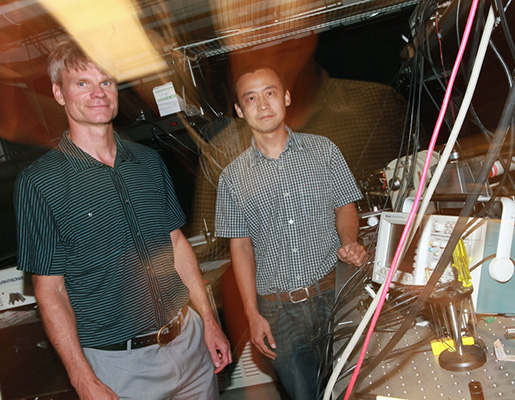It’s a small world
Nonlinear magneto-plasmonics can mean big things at the atomic scale
The surface of a metal seems smooth, but a closer look—much closer, at the atomic level—will show that the same surface resembles the surface of a beehive.
Most of this surface busyness of a metal comes from its own free electrons, reacting to electromagnetic charges and other stimuli to such a degree that they behave like a plasma, which is why the study of the phenomenon is called “plasmonics.” Scientists are working to manipulate and harness these atomic-level surface interactions, paving the way for the development of a whole new range of high-tech devices and applications.
A research group based at William & Mary has advanced the understanding of an important property of plasmonics, devising a method to regulate the magnetic contrast of the effect. It’s essentially like inventing a more sensitive plasmonics “volume control,” the scientists say.
The group published their results in Scientific Reports, an online publication of Nature. The authors on “Control of magnetic contrast with nonlinear magneto-plasmonics,” are Wei Zheng, a research scientist at William & Mary and Gunter Lüpke, professor of applied science at the university, along with Aubrey Hanbicki and Berend Jonker of the Naval Research Laboratory’s Materials Science & Technology Division. Their work was supported by the U.S. Department of Energy, as well as the Office of Naval Research.
Zheng explained that the paper outlines the group’s creation of a new subfield in plasmonics.
“It’s a very new area of study,” he said. “We call it nonlinear magneto-plasmonics.”
The term was coined at William & Mary
Nonlinear magneto-plasmonics—a term coined by the group— is based on the researchers’ new method to combine two surface effects, resulting in increased signal strength and sensitivity. Lüpke explained that the “nonlinear” part refers to Zheng’s innovation to produce an enhanced optical effect, working with lasers on an iron-magnesium oxide surface.
“Usually one uses what is called linear optical,” Lüpke said. “You shine light on it and you look at the reflected light, and you don’t use anything with it. But he actually puts the light in and it doubles the frequency of the light—you send in red light and blue light comes out.”
This enhanced optical effect works with surface plasmonics in a way that makes the best of both phenomena, the plasma-like electrons concentrate the light, allowing the experimenter to confine or focus the light in an area as small a few nanometers. This hybrid approach can offer resolution far beyond what optical microscopes can provide.
“Usually, optics are limited by the wavelength—typically a micron or a sub-micron. That’s what you usually use in an optical microscope so you can study biological cells, which are tens to hundreds of microns,” he said.
Study individual proteins in a cell
Cells are made up of lots and lots of individual proteins, the object of study by scientists in rapidly expanding fields such as proteomics and genomics. Observation of proteins require sensitivity of at least a couple orders of magnitude higher that the best optical microscope can provide. Lüpke said that nonlinear magneto-plasmonics has the potential to provide an additional tool for the study of proteins, in addition to the electron microscope commonly used in labs.
Another potential application of the group’s work is for the development of smaller, more efficient magnetic storage devices. The researchers devised a way to exploit an unusual material property.
“Traditional magnetic storage only have two magnetic states, negative or positive,” Zheng explained. “But, single-crystal iron film, a very common magnetic material, actually has four magnetic states, but traditional magnets can only detect two of them.”
He explained that they figured out how to “tune” the shape of the magnetic loop field to detect all four magnetic states in single-crystal iron film. The discovery sets the stage for possible development of a new class of what is known as quaternary magnetic storage systems—hard drives and flash drives made of material that can hold double the capacity.
The work builds on an earlier paper in Nature Nanotechnology, “Exchange bias of the interface spin system at the Fe/MgO interface,” and on a long-standing collaboration with the Office of Naval Research. ![]()
















